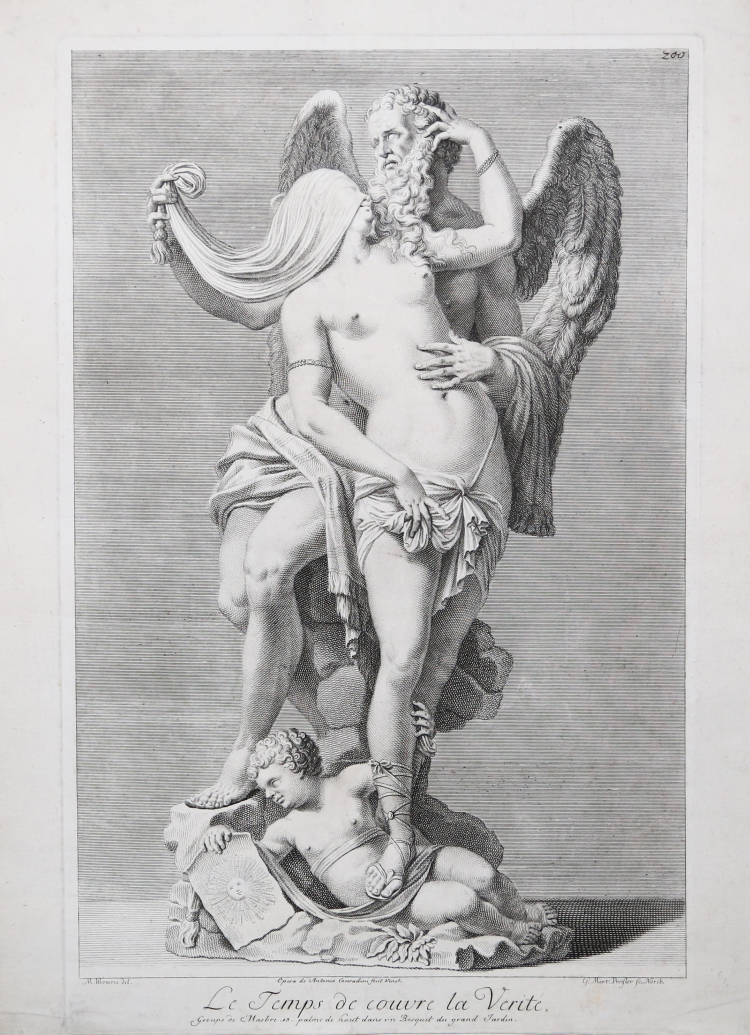



| Reference: | S44194 |
| Author | Johann Martin PREISSLER |
| Year: | 1735 |
| Measures: | 320 x 495 mm |


| Reference: | S44194 |
| Author | Johann Martin PREISSLER |
| Year: | 1735 |
| Measures: | 320 x 495 mm |
Etching and engraving, 1735, signed in plate at lower right G. Mart, Preisler sc. Norib.
From the statue of Antonio Corradini in the Großer Garten in Dresden.
Following the example of Tsar Peter the Great, who embellished Russian palaces, summer residences, ceremonial gardens, and monuments with works of art from Italy, Augustus II, Elector of Saxony and King of Poland, with the aim of beautifying the capital Dresden, put together a huge collection of paintings and sculptures with the help of art dealers and his agents, such as Kinderman and Raymond Le Plat. Three sculptors active in Venice, among others, were involved in the plastic decoration of the grounds of the Holländisches Palais: in addition to Antonio Corradini, Pietro Baratta and Filippo Catasio.
In 1728 the Holländisches Palais underwent restoration work, and the statues there were transferred to the Großer Garten. During the ruinous siege suffered by Dresden in 1760 many statues were destroyed, and in the 19th century other sculptures were sold on the antiques market. The park currently preserves only nine of the twelve works created by Corradini, all of which were illustrated in a printed catalog published in Dresden in 1733, edited by Raymond Le Plat.
Plate from Recueil des marbres antiques qui se trouvent dans la Galerie du Roy de Pologne à Dresden […], published in Dresden by Raymond Le Plat, in 1735.
The collection of ancient and modern art at Dresden had been established by Friedrich August I (“Augustus the Strong”), who died in the same year as this book was published. He had bought antiquities from Frederick William I of Prussia (including the Bellori collection of Roman portraits) and from the Chigi and Albani families of Rome (including sculpture, vases, bronzes and mummies). Several Roman antiquities had arrived in Dresden as recently as 1729.
The plates have no accompanying explanatory texts, but most are captioned. Subjects are chiefly mythological (the collection includes copies of some famous works, such as Praxiteles's “Satyr” and Scopas's “Maenad tearing a goat”).
Almost all the plates are signed by draughtsmen and engravers. The draughtsmen were A.M. Wernerin, Joh. Justin Preissler, M. Tuscher or H. Preissler. The engravers were Lorenzo Zucchi, C.F. Boetius, Georg Mart. Preissler, Johann Balthasar Probst, Bernigeroth, Johann David Hertz, Iac. Gottlieb Thelot, Iac. Andr. Fridrich, Christian Philipp Lindemann, Hieronymus Sperling, “MB”, Joh. Jac. Steltzer or Chr. Raym. Thoman.
Etching, in very good condition.
|
German engraver, the son of Johannes Daniel Preisler. He was most notable for his portraits and a series of twenty-one engravings of classical and neo-classical sculptures in Rome, based on drawings made there by his brother Johan Martin. He died 29 August 1754, Nuremberg.
|
|
German engraver, the son of Johannes Daniel Preisler. He was most notable for his portraits and a series of twenty-one engravings of classical and neo-classical sculptures in Rome, based on drawings made there by his brother Johan Martin. He died 29 August 1754, Nuremberg.
|